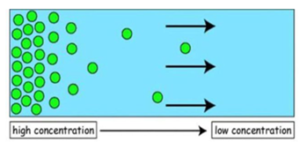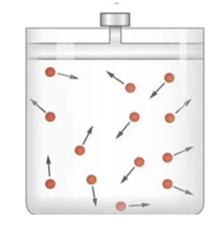- Diffusion is the net movement of molecules from a region of higher concentration to a region of lower concentration down a concentration gradient as a result of their random movement.
Watch the Video at the End of This Blog to Unlock the Mysteries of Cellular Diffusion ↓
This article will serve as a place for you to understand what diffusion is and how it takes place. We will also learn about Brownian motion.
What is Diffusion?
We will first address this definition very simply.

In the diagram above, we can see a blue rectangle and this can be considered the space. The little green circles represent the particles. The particles are all concentrated at one end of the space, while the other end of the space is completely empty.
Diffusion can simply be defined as these particles having a natural tendency to spread out from this region where there are more of them (region with a high concentration), to the region where there are less of them (region with a lower concentration).
Since the basic concept has been explained, the exact definition is:
Diffusion is the net movement of molecules from a region of higher concentration to a region of lower concentration down a concentration gradient as a result of their random movement.
What does net movement of molecules mean?
These molecules do not have a clear pathway. Instead, they move randomly. Although they are in random motion, every particle moves by the process of diffusion. Even though the movement of each individual particle is random, when we look at the net movement of all particles, the net movement is from a region of higher concentration towards a region of lower concentration. This is why we use the term net movement.
What does ‘down a concentration gradient’ mean?
If we once again look at the picture above, we can see that the region on the left has many particles, therefore has a higher concentration, while the region on the right has less particles, therefore has a lower concentration. This difference in the concentrations is what we refer to as a concentration gradient.
Since the particles are moving from a higher concentration to a lower concentration, we call this moving down a gradient. It moves down the concentration gradient as a result of their random movement.
The key terms of this definition would therefore be:
– Movement of particles
– Higher concentration
– To lower concentration
– Down a concentration gradient
– Random movement
This is the definition of diffusion you need to write if you are asked for it at the exam.
The question in our mind would be why is diffusion so important in Biology? Where exactly does the concept of diffusion apply inside biological organisms?
The answer is that diffusion takes place across every single cell in our body. We have all learnt what the structures of the cell are and that the simplest cell would usually contain a nucleus in the centre, a cell membrane, and cytoplasm. We have also learnt that multicellular organisms, like us humans, have billions of cells in our body. Diffusion therefore, takes place inside almost every single one of these cells.
Why does diffusion need to take place in our cells?
Let us imagine that there is some kind of a useful substance that is outside the cell, and that substance is available in a high concentration. We can also imagine that this useful substance is only available in a low concentration inside the cell.
From what we have learnt for diffusion, we would now understand that these particles can move from this region of high concentration to a region of lower concentration by the process of diffusion. Hence, more of these useful substances will enter the cell through diffusion.
Diffusion is therefore important in absorbing useful substances into the cell.
In a very similar manner, let us imagine that the cell has produced waste products, and these waste products are now at a high concentration inside the cell. Comparatively, outside the cell, there is a lower concentration of waste products.
We have understood that where there is one region with substances having a higher concentration and another region having a lower concentration, diffusion is going to take place and these particles are going to move down the concentration gradient, so in other words, these waste substances will move out of the cell (where there is a lower concentration of waste products to be found).
Therefore, diffusion is also important in the removal of waste products from the cell.
This is how diffusion is applicable in a living organism; some substances move into the cell and some substances move out of the cells by diffusion through the cell membrane.
What is the driving force behind diffusion?
Another question that we can ask is where do these particles get the energy to diffuse from one place to another?
The energy for diffusion comes from the kinetic energy of random movement of molecules and ions. If we consider any molecule or any ion, these molecules are all in motion, and they are all moving about randomly. This random motion is known as Brownian motion.
Brownian motion is the random motion shown by molecules and ions, and this random motion is a result of the kinetic energy of particles.
So all these particles contain kinetic energy and this kinetic energy is what drives their random motion. As particles move randomly, they collide with each other and with the walls of their container, causing them to spread out and move from areas of high concentration to areas of low concentration.

We know that kinetic energy is a measure of the motion of particles, and kinetic energy is directly related to temperature. In fact, kinetic energy is directly proportional to the temperature. Hence if the temperature of this container shown above increases, the kinetic energy increases as well. Particles having greater energy will lead to a higher rate of random movement, and therefore, a higher rate of diffusion.
Refer to the video below to see examples of cellular diffusion for easier reference!
Revising unlocking the Mysteries of Cellular Diffusion
Diffusion is one of the most important processes in which substances move in and out of cells. Make sure you study the full definition as it is a frequent question for the exams.
Some questions on movement into and out of cells can be found here as well, and you can time your answers to see if you can complete the quiz within the time limit.
If you are struggling with IGCSE revision or Biology in particular, you can reach out to us at Tutopiya to join revision sessions or find yourself the right tutor for you.
Attempt the quiz to know where you stand!






